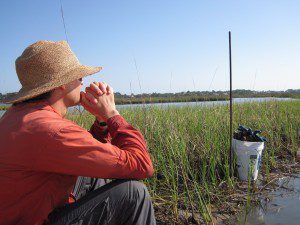Rob Diaz de Villegas WFSU-TV
For a few months now, we’ve been telling you about an extensive field experiment being conducted for the biogeographic oyster study. As David posted earlier, it was a complex undertaking that took a lot of hard work- long hours and physical labor- to get up and running. Now, thanks to Hurricane Irene, they have to tear down about a month ahead of time. While it no longer looks likely to hit David’s St. Augustine site, it might hit some of the other team’s sites in the Carolinas (or at least bring heavy rain). In order for the data to be consistent, once one site starts tearing down, they all do. That’s the challenge of conducting a study where you look at effects over a large geographic expanse- staying consistent when so many things can vary across the miles. Even the manner in which the cages are taken down is important; all of the Primary Investigators (the team leaders) were to have met in Skidaway, Georgia next month to decide how to proceed on that front. Now, they’ll have to figure it out on the fly.
David will be updating us on the progress of the experiment tear down as it happens, so stay tuned!

